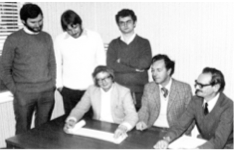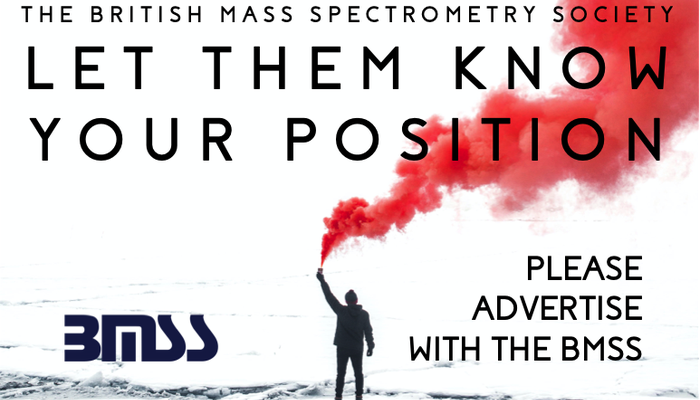Bordoli Prize
The BMSS awards the Bordoli Prize, in honour of Bob Bordoli, to the best early career scientist’s poster presentation.
 |
Picture taken from the VG Analytical Insight No.10, Dec1980. A technical note announcing Fast Atom Bombardment. The authors are left to right (standing) Vic Parr, Bob Bordoli, Andy Tyler and left to right (seated) Mickey Barber, Don Sedgwick and Brian Green. |
(1953 - 2000) graduated from UMIST with a BSc degree in chemistry in 1974, followed by a PhD with John Vickerman on the use of Static Secondary Ion Mass Spectrometry. As part of this work that led to the development of a Fast Atom Bombardment Quadrupole Mass Spectrometer (J. Chem Soc. Chem. Comm. 1981: 324-325), Bob constructed the first fast atom beam system for SIMS.
Next, as a post-doctoral fellow with Mickey Barber, Bob worked on the development of the first FAB source for organic mass spectrometry. The Chem. Comm. paper on FAB by Barber, Bordoli, Sedgwick and Tyler contained a prophetic statement concerning “the inadequacies of most mass spectrometers in terms of their energy focusing and ion source extraction of the high masses which this new ion source now makes possible”. Overcoming these problems, especially for the study of biological molecules, was the single theme that dominated the remainder of Bob’s career and this was a task to which Bob’s special combination of instrument development expertise and chemical problem solving ability made him uniquely suited.
In 1983, Bob joined VG Analytical, now Waters, as a development scientist and became involved in evaluating the ZAB-4F, the first commercial four sector MS/MS system, for the structural determination of biological molecules ionized by FAB. He then worked on the development of the ZAB-SE, with a mass range of 15,000 at full sensitivity, and the ZAB-SE-4F, probably the longest ever commercial mass spectrometer! He later became product manager for the AutoSpec, moving in 1991 to the AutoSpec-T, the tandem ‘four-sector’ MS/MS system with array detector. He then worked on the development of the array detector on the AutoSpec-FPD, the ZabSpec-T ‘four-sector’ MS/MS instrument, the ZabSpec-FPD focal plane detector instrument, and the ZabSpec-Ultima, a 120,000 resolution version of the ZabSpec. There followed another prolific period of Bob’s career when he became involved in the development of the Q-TOF series of instruments. In January 1996 he started to use the prototype Q-TOF for the analysis of biological samples by MS/MS. He presented the first results from the Q-TOF at the ASMS meeting in Portland, and he co-authored the first paper on it (Rapid Commun. Mass Spectrom.1996; 10: 889-896). From 1998 to 2000, Bob was involved in coordinating his company’s approach to proteomics, encompassing MALDI, nanoflow LC-MS and MS/MS on the Q-TOF, and the extensive use of software. He was particularly involved in the evaluation of the new maximum entropy software for de-novo sequencing of peptides. He also became involved with the evaluation and development of the MALDI source on the Q-TOF. Bob’s industrial career led to over 50 published papers and to numerous conference contributions, often the key indicator for staff from instrument manufacturers. These were in addition to the many papers that had resulted from his UMIST career. Bob was an excellent lecturer and, as a result, he became in many ways the face of his company to the scientific community.
Bob died in 2000 at the age of 47, as a result of a recurrence of a cancer that first attacked him in 1997.

